1. Some Ancient Religious Buildings in Vietnam
Religious architecture is a defining part of Vietnam’s heritage, with historical buildings in Vietnam such as pagodas, temples, and communal houses spread across the country. These sacred structures, found from north to south, stand as remarkable testaments to Vietnam’s rich spiritual and architectural traditions.1.1. One Pillar Pagoda: Hanoi’s Iconic Buddhist Temple
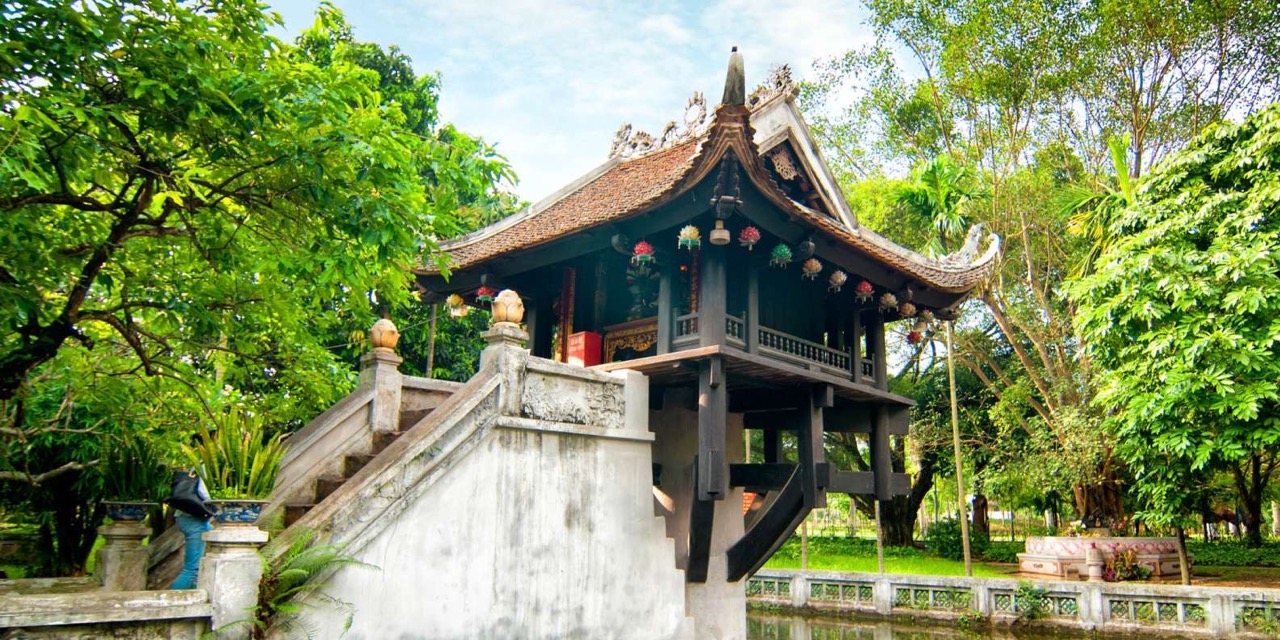 Standing like a lotus flower rising from the water, the One Pillar Pagoda is one of the most unique historical buildings in Vietnam. Built during the Ly Dynasty in 1049 by Emperor Ly Thai Tong, this unique pagoda was designed to resemble a lotus blossom, symbolizing purity in Buddhist philosophy. The structure’s distinctive design features a small wooden temple balanced atop a single stone pillar rising from an artificial pond. According to legend, the emperor built the pagoda after dreaming of meeting the bodhisattva Avalokiteshvara, who handed him a lotus flower while seated on a lotus throne.
Though the original structure was destroyed during the French withdrawal from Vietnam in 1954, the pagoda was carefully reconstructed to preserve its historical significance. Today, the One Pillar Pagoda remains an important symbol of Hanoi and Vietnamese Buddhism, with many visitors coming to make offerings for fertility and good health.
Standing like a lotus flower rising from the water, the One Pillar Pagoda is one of the most unique historical buildings in Vietnam. Built during the Ly Dynasty in 1049 by Emperor Ly Thai Tong, this unique pagoda was designed to resemble a lotus blossom, symbolizing purity in Buddhist philosophy. The structure’s distinctive design features a small wooden temple balanced atop a single stone pillar rising from an artificial pond. According to legend, the emperor built the pagoda after dreaming of meeting the bodhisattva Avalokiteshvara, who handed him a lotus flower while seated on a lotus throne.
Though the original structure was destroyed during the French withdrawal from Vietnam in 1954, the pagoda was carefully reconstructed to preserve its historical significance. Today, the One Pillar Pagoda remains an important symbol of Hanoi and Vietnamese Buddhism, with many visitors coming to make offerings for fertility and good health.
1.2. Thien Mu Pagoda: The Celestial Lady of Hue
 Overlooking the Perfume River in Hue, Thien Mu Pagoda is one of the most famous historical buildings in Vietnam and an enduring symbol of the former imperial capital. Originally built in 1601 during the Nguyen Dynasty, the pagoda’s name translates to “Celestial Lady”, referring to a local legend about an old woman who prophesied that a lord would build a pagoda on the hill to pray for the country’s prosperity.
This historical buildings in Vietnam’s most recognizable feature is its seven-story octagonal tower (Phuoc Duyen), with each level dedicated to a different Buddha manifestation. Standing 21 meters tall, this tower has become an emblematic image of Hue and appears on many Vietnamese banknotes and stamps.
Beyond their architectural beauty, these historical buildings in Vietnam played a pivotal role in Buddhist protests during the 1960s. The site houses the Austin car that monk Thich Quang Duc drove to his self-immolation protest in 1963, making the pagoda not just a religious landmark but also a significant historical site connected to Vietnam’s modern struggles.
Visitors to Thien Mu can explore not only the main pagoda but also the surrounding temple complex with its tranquil gardens, meditation halls, and living quarters for monks. The hilltop location offers breathtaking views of the Perfume River, making it one of Vietnam’s most picturesque religious sites.
Overlooking the Perfume River in Hue, Thien Mu Pagoda is one of the most famous historical buildings in Vietnam and an enduring symbol of the former imperial capital. Originally built in 1601 during the Nguyen Dynasty, the pagoda’s name translates to “Celestial Lady”, referring to a local legend about an old woman who prophesied that a lord would build a pagoda on the hill to pray for the country’s prosperity.
This historical buildings in Vietnam’s most recognizable feature is its seven-story octagonal tower (Phuoc Duyen), with each level dedicated to a different Buddha manifestation. Standing 21 meters tall, this tower has become an emblematic image of Hue and appears on many Vietnamese banknotes and stamps.
Beyond their architectural beauty, these historical buildings in Vietnam played a pivotal role in Buddhist protests during the 1960s. The site houses the Austin car that monk Thich Quang Duc drove to his self-immolation protest in 1963, making the pagoda not just a religious landmark but also a significant historical site connected to Vietnam’s modern struggles.
Visitors to Thien Mu can explore not only the main pagoda but also the surrounding temple complex with its tranquil gardens, meditation halls, and living quarters for monks. The hilltop location offers breathtaking views of the Perfume River, making it one of Vietnam’s most picturesque religious sites.
1.3. Van Duc Pagoda: Hoi An Buddhist Treasure
As a remarkable historical buildings in Vietnam, just 5 kilometers from Hoi An’s Ancient Town sits Van Duc Pagoda, a spiritual centerpiece dating back to the late 17th century. Founded by Zen master Minh Luong, this temple has served as a meditation and Buddhist teaching center for over three centuries.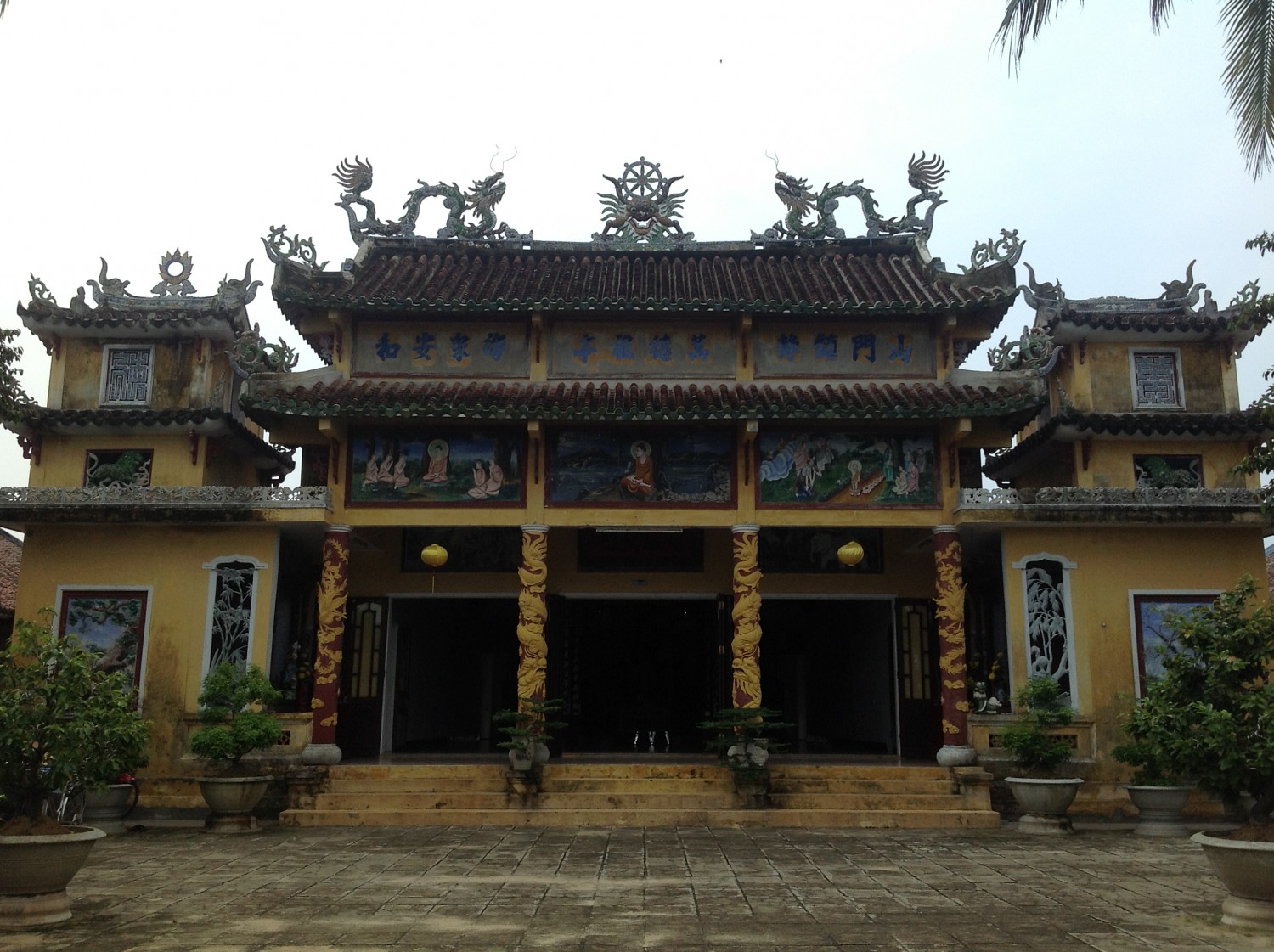 The pagoda exemplifies traditional East Asian design principles with its U-shaped layout spanning approximately 6 hectares along the De Vong River. What I find particularly striking are the curved tiled roofs and intricate details featuring dragons, lions, turtles, and phoenixes – symbols deeply significant in Vietnamese culture. Surrounded by willow and fruit trees, the temple includes a three-door gate that serves as a threshold between the secular and sacred worlds. This architectural arrangement is typical of Vietnamese Buddhist temples, where the design itself guides visitors on a spiritual journey.
What makes Van Duc Pagoda truly remarkable is its collection of 115 wooden printing blocks containing ancient Buddhist texts, some dating back to 1482 during the Le Dynasty. The pagoda houses 22 Buddhist statues, including representations of Amitabha, Shakyamuni, and Maitreya Buddhas. Its 1.2-meter tall bronze bell with dragon-shaped handles continues to call the faithful to prayer, while Ming and Qing dynasty ceramics showcase the pagoda’s historical connections to China. These artifacts aren’t merely museum pieces – they remain actively integrated into religious practices.
The pagoda exemplifies traditional East Asian design principles with its U-shaped layout spanning approximately 6 hectares along the De Vong River. What I find particularly striking are the curved tiled roofs and intricate details featuring dragons, lions, turtles, and phoenixes – symbols deeply significant in Vietnamese culture. Surrounded by willow and fruit trees, the temple includes a three-door gate that serves as a threshold between the secular and sacred worlds. This architectural arrangement is typical of Vietnamese Buddhist temples, where the design itself guides visitors on a spiritual journey.
What makes Van Duc Pagoda truly remarkable is its collection of 115 wooden printing blocks containing ancient Buddhist texts, some dating back to 1482 during the Le Dynasty. The pagoda houses 22 Buddhist statues, including representations of Amitabha, Shakyamuni, and Maitreya Buddhas. Its 1.2-meter tall bronze bell with dragon-shaped handles continues to call the faithful to prayer, while Ming and Qing dynasty ceramics showcase the pagoda’s historical connections to China. These artifacts aren’t merely museum pieces – they remain actively integrated into religious practices.
2. War Memorials in Vietnam: Honoring the Past
Vietnam’s tumultuous 20th century is commemorated through various war memorials that provide powerful testimonies to the country’s struggles for independence.2.1. The Vietnam War Remnants Museum
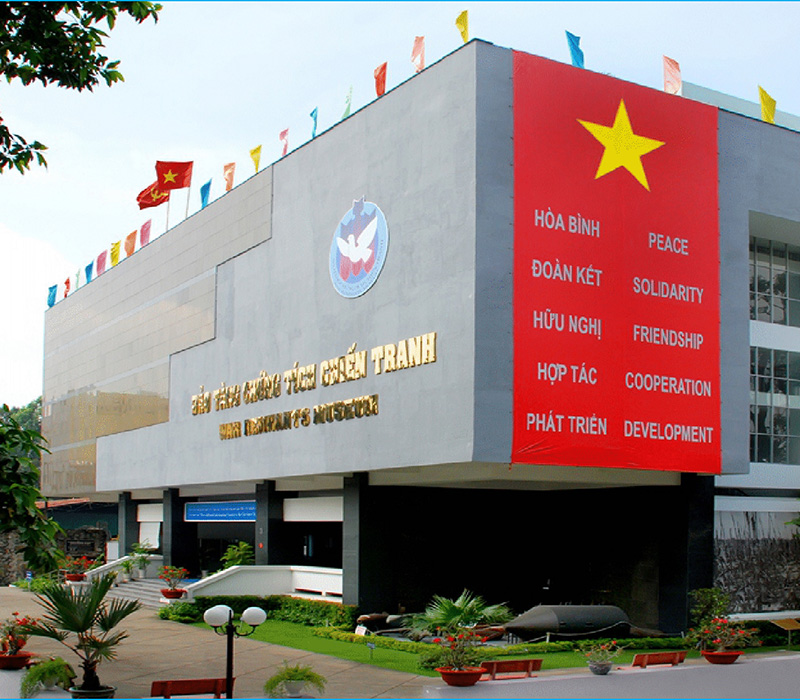 The Vietnam War Remnants Museum, one of the most significant historical buildings in Vietnam, offers a powerful look into the impact of the Vietnam War. Located in Ho Chi Minh City, the museum houses an extensive collection of photographs, documents, and military artifacts that depict the realities of war. Exhibits include preserved tanks, aircraft, and harrowing accounts of Agent Orange’s effects.
The Vietnam War Remnants Museum, one of the most significant historical buildings in Vietnam, offers a powerful look into the impact of the Vietnam War. Located in Ho Chi Minh City, the museum houses an extensive collection of photographs, documents, and military artifacts that depict the realities of war. Exhibits include preserved tanks, aircraft, and harrowing accounts of Agent Orange’s effects.
Read more about the War Remnants Museum in our blog here!
As a must-visit historical buildings in Vietnam, the museum serves as a solemn reminder of the country’s past struggles while educating visitors on the resilience and strength of the Vietnamese people in the face of adversity.2.2. The Cu Chi Tunnels: A Monument to Resistance
 Located about 70 kilometers northwest of Ho Chi Minh City, the Cu Chi Tunnels stand as a remarkable historical building in Vietnam, symbolizing the resilience and ingenuity of the Vietnamese people during the Vietnam War. The network included living quarters, kitchens, meeting rooms, hospitals, and weapon factories – essentially an entire community underground. These are a powerful statement of human flexibility and adaptability – architecture not born of beauty aims but of survival needs, but no less valuable in terms of engineering and history.
Today, visitors can explore sections of the tunnels, experiencing firsthand the challenging conditions faced by those who lived and fought there. As one of the most significant historical buildings in Vietnam, the Cu Chi Tunnels offer a powerful glimpse into the country’s wartime history and enduring spirit of resistance.
Located about 70 kilometers northwest of Ho Chi Minh City, the Cu Chi Tunnels stand as a remarkable historical building in Vietnam, symbolizing the resilience and ingenuity of the Vietnamese people during the Vietnam War. The network included living quarters, kitchens, meeting rooms, hospitals, and weapon factories – essentially an entire community underground. These are a powerful statement of human flexibility and adaptability – architecture not born of beauty aims but of survival needs, but no less valuable in terms of engineering and history.
Today, visitors can explore sections of the tunnels, experiencing firsthand the challenging conditions faced by those who lived and fought there. As one of the most significant historical buildings in Vietnam, the Cu Chi Tunnels offer a powerful glimpse into the country’s wartime history and enduring spirit of resistance.
3. Famous Monuments in Vietnam
3.1. The Imperial City of Hue
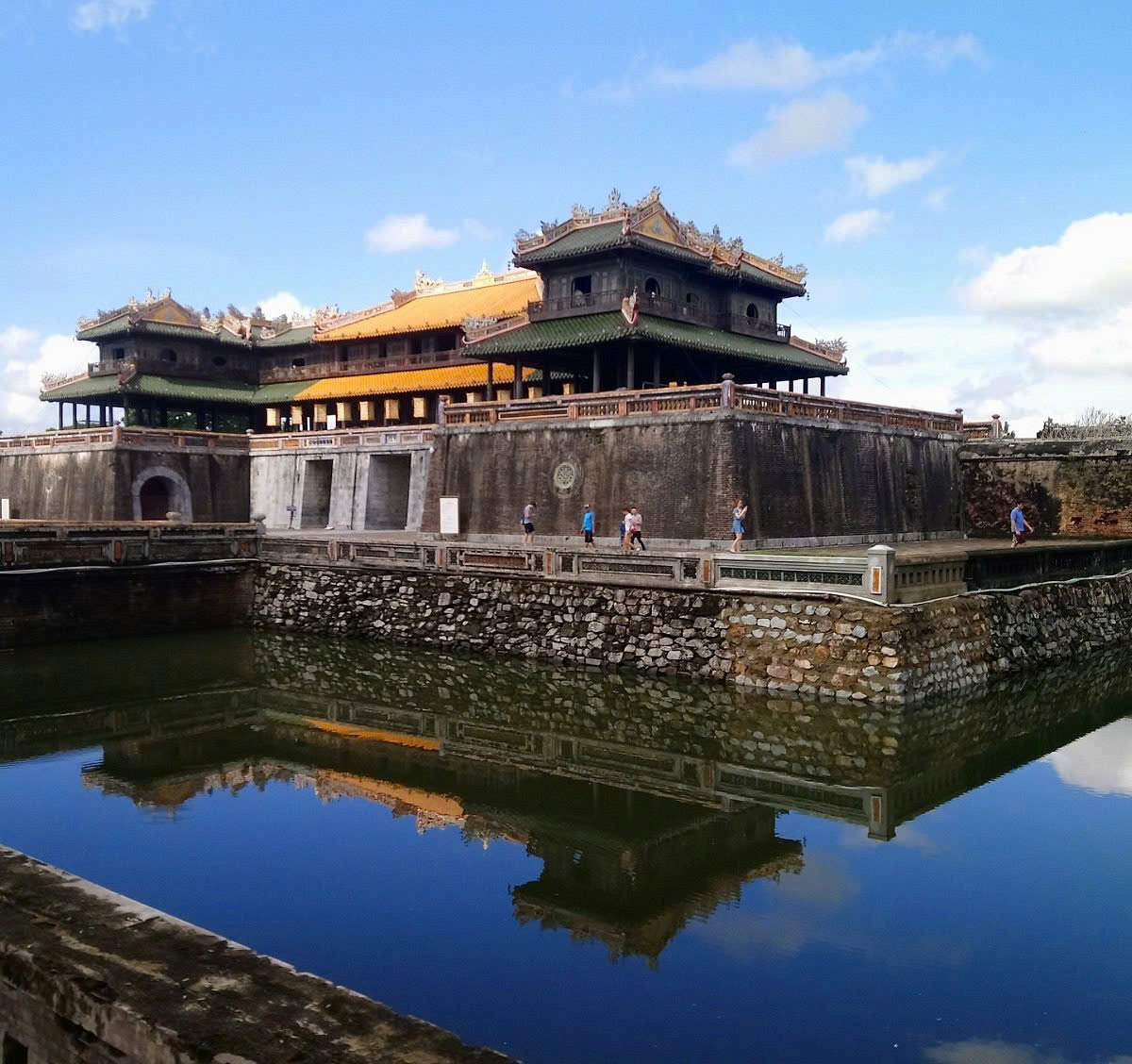 The Imperial City of Hue, a UNESCO World Heritage Site, is one of Vietnam’s most important monuments. Built in the early 19th century, it was the political and cultural center of Vietnam during the Nguyen Dynasty. The site features grand palaces, temples, and gates that showcase the grandeur of Vietnamese architecture and its royal past. As one of the most well-preserved historical buildings in Vietnam, the Imperial City offers visitors a glimpse into the country’s imperial past, showcasing its rich heritage and artistic mastery.
The Imperial City of Hue, a UNESCO World Heritage Site, is one of Vietnam’s most important monuments. Built in the early 19th century, it was the political and cultural center of Vietnam during the Nguyen Dynasty. The site features grand palaces, temples, and gates that showcase the grandeur of Vietnamese architecture and its royal past. As one of the most well-preserved historical buildings in Vietnam, the Imperial City offers visitors a glimpse into the country’s imperial past, showcasing its rich heritage and artistic mastery.
3.2. The Flag Tower of Hanoi
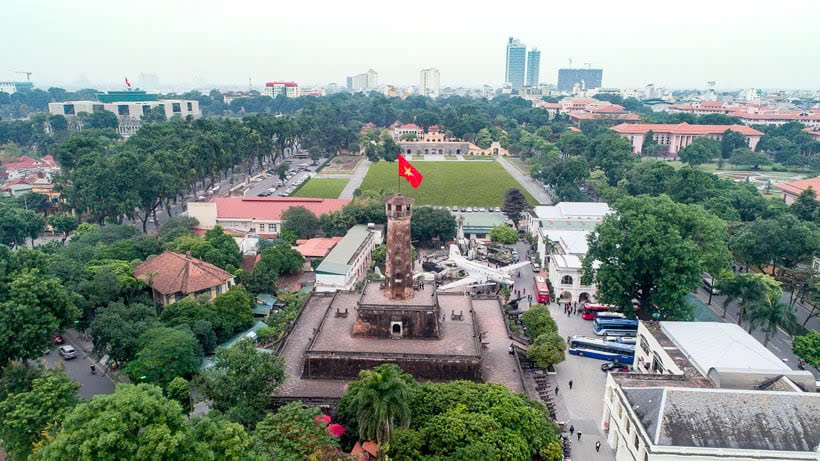 One of Hanoi’s most famous monuments in Vietnam, the Flag Tower of Hanoi, was built in 1812 by Emperor Gia Long. The tower has witnessed numerous pivotal moments in Vietnam’s war and has become a symbol of Vietnamese independence and resilience. Nowadays, tourists can climb the tower, enjoying panoramic views of Ba Dinh Square and the cityscape, by a staircase with around 200 steps.
One of Hanoi’s most famous monuments in Vietnam, the Flag Tower of Hanoi, was built in 1812 by Emperor Gia Long. The tower has witnessed numerous pivotal moments in Vietnam’s war and has become a symbol of Vietnamese independence and resilience. Nowadays, tourists can climb the tower, enjoying panoramic views of Ba Dinh Square and the cityscape, by a staircase with around 200 steps.
